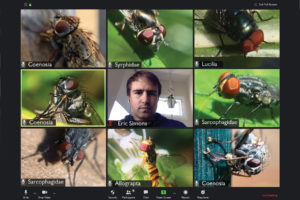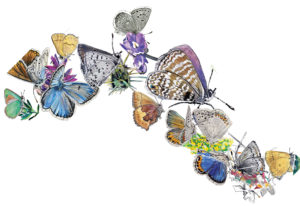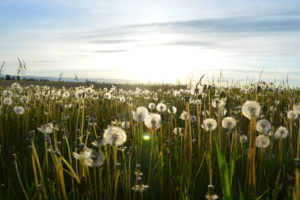If not for an unassuming wire fence, you might mistake Judith Larner Lowry’s garden for one of nature’s own. The tall wooden gate resists slightly, then yields, permitting the visitor to step into a quiet community of coastal scrub. Undulating stands of coyote brush stretch in all directions, some low, some tall. Within this architecture, one begins to notice dozens of other species: Toyon is growing here, as are ceanothus and manzanita. Soaproot flower stalks, open and lanky, sprawl above coffeeberry, sticky monkeyflower, and seaside daisies. Dune tansy nods. Drifts of poppies and late-blooming wildflowers hail the breeze and wave satiny petals to the sun.
Wildflowers are Lowry’s stock in trade—she sells native plant seed for California homes and gardens. Founded more than 20 years ago, Larner Seeds has grown to include a nursery, workshops, site consultations, and garden installation. Lowry’s “Notes on Natives” pamphlets recently blossomed into Gardening With a Wild Heart, a meditative synthesis of her experience as a gardener and purveyor of native plants.
In the book, Lowry makes the case for gardening as a form of ecological restoration. “Using species in the local native plant palette to make comfortable, useful, beautiful gardens,” she writes, “can also help restore ecosystems that have been fragmented or lost.” To the extent possible, the backyard restoration gardener seeks to rebuild native plant and animal communities as they exist in the wild. He or she considers the yard as it must have been, and looks to intact plant communities for ideas about what it could become
Lowry’s own backyard sits on a marine terrace that was once—and in her yard is again—a rich complex of coastal plant communities, including scrub, prairie, and woodland. In the demonstration garden, through which visitors enter the property, the dominant community is scrub. “I started with dune and bluff species,” Lowry says, “but they died out.” Other plants like coyote brush, which was already on the site, flourished. Lowry took her cue from the land itself, and began to structure the demonstration garden around that keynote shrub. Amid the islands and hedges she has created with coyote brush, she has interspersed a wild diversity of forbs—broad-leaved annuals—and smaller shrubs.
Lowry has been working on her site, which covers just under an acre, for nearly two decades. When she began, it was almost entirely overrun with invasive exotics that she gradually removed by hand. Though invasive, such thickets nonetheless harbored wildlife that would have been rendered homeless by large-scale clearance. “Before we cleared one small area of broom and Cape ivy,” she says, “we established another area for habitat with toyon and coffeeberry.”
Over the years in this gar-den, the animal that Lowry has bonded with most is the California quail. Though they can fly, quail seldom do so for very long—they are, essentially, a terrestrial species. In environments with buildings and roads, most birds can fly from danger or to find food and shelter. But quail, like other animals anchored to the ground, have more to overcome in securing their needs.
Out here on the Bolinas Mesa, though, the quail feel right at home. Flocks scurry across the dirt roads, raising a ruckus. From the shelter of thickets they chortle and scold. They are year-round residents whom Lowry has courted with a mosaic of shrubs and bunchgrasses, open spaces and hiding places tailored to meet their preferences. They have graced her garden with their abiding presence.
For her human neighbors, Lowry has some ideas for landscaping as well. Rather than making windbreaks from short-lived or invasive species like Monterey cypress or blue gum eucalyptus, Lowry recommends what she calls the “Bolinas Hedge,” a mix of coffeeberry, California wax myrtle, creek dogwood, and California hazelnut. All occur locally, grow without much water, and require little pruning. And, of course, they’re better for local wildlife.
To illustrate that native plants can satisfy a variety of tastes, Lowry has formally pruned a hazelnut shrub on one side of her office door and let one grow naturally on the other. She has a small cottage garden around the patio outside her office, where she has used a variety of California natives—some cultivars, not all local—to create an intimate, flower-filled setting that would charm even the most recalcitrant conventional gardener. Wildflowers, she says, are an easy way to win anyone over to an appreciation of the beauty of native plants.
As a backyard restorationist, Lowry might say that gardening is about participating, not creating. When red-ribbon clarkia appeared in a corner of her garden, Lowry fell down on her knees in delight. “I had never seen it here. I’d seen it three miles from here, but not here. And this is the experience as a gardener that I treasure most: when plants move around, when other plants appear. Then I know that things are happening without me.”

.jpg)



